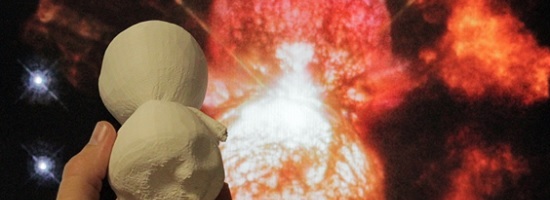
Exploring NASA’s History of 3D Printing: Tools, Community Challenges, and Scale Models You Can Print at Home
When it comes to 3D printing, NASA has always been a forerunner. Not only are they using the first 3D printer in space to print tools and spare parts on the International Space Station (ISS), but they also manage to actively include their community in their projects. In this post, we review NASA’s contribution to the field of 3D printing and take a look at their 3D model database and show you how it can be used to create 3D prints.
Fifty-four years ago today, Yuri Gagarin was the first human to launch into space. Exactly 20 years later, on April 12th 1981, NASA launched its first Space Shuttle mission. Since then, space exploration and the equipment needed has become more and more advanced, and now increasingly uses and relies on 3D printing to meet the needs of modern space travel and the challenges it presents.
Despite being the experts in engineering for space travel, over time NASA realized that the biggest source of expertise and creativity to help them solve new challenges lay in its community. In July 2014, NASA encouraged people to participate in a “Mars Base Challenge”. Participants were asked to design a 3D model of a Mars base that can withstand the brutal environment of the Red Planet while delivering a smart, functional design. Take a look at two of the winning entries below:

Left: Martian Pyramid by Valcrow. Right: The Queen B by Noah Hornberger
A few weeks later, NASA announced that it had created the first full 3D model of the Eta Carinae Nebula. Eta Carinae lies about 7,500 light-years away from Earth and is one of the most massive binary systems astronomers are able to study in detail. The primary star is about 90 times the mass of the Sun and emits 5 million times the Sun’s energy output. NASA uses the 3D model to gain information about the physical mechanisms that are responsible for forming this enormous cloud of gas and dust.

A 3D printed model of the Homunculus Nebula is compared with a Hubble image of the object (photo credit: NASA)
In November 2014, the guys from MadeInSpace and NASA started to email 3D files for tools and spare parts to the ISS. With a 3D printer on board, the crew of the ISS can now simply receive these files and print needed objects whenever it is necessary, saving precious time until the launch of the next supply rocket. In early 2015, NASA encouraged its community to submit new designs to be sent to the ISS in their “Space Tool Challenge”, allowing them to participate in making space travel better, one 3D print at a time.

3D Printer in the Microgravity Science Glovebox on the ISS (photo credit: NASA)

ISS Commander Butch with his new 3D printed ratcheting socket wrench (photo credit: NASA)
In yet another 3D printing-related project – NASA 3D Resources – NASA released 3D printable models on their website. This database includes models of asteroids, spacesuits, robots, rovers, rockets, Space Shuttles, the ISS, as well as satellites, probes, and space telescopes such as Kepler, Hubble, Galileo, Deep Impact, Cassini, Voyager, or Rosetta, to name a few.
Users are even able to download some of the objects that were printed on the ISS, including the first 3D printed object made in space for use by an astronaut: when Station Commander Barry Wilmore needed a wrench, NASA emailed him this 3D model.

Screenshot of the NASA 3D Resources database of 3D models (image credit: NASA)
NASA offers these 3D files for anyone to download and use for free. They all make for great 3D printing projects for anyone interested in learning more about our galaxy and NASA’s technology, or using them for education or research. When browsing through NASA’s library, we couldn’t wait to download some models and print them ourselves. Check out the video below to see the results of our 3D prints of models like the ISS and the Space Shuttle:
More and more companies and organizations are now putting 3D models online and asking their communities to use and contribute files. In this way, organizations like NASA help get us more connected to their projects. Who would have thought that 54 years after sending Yuri Gagarin into space, a 3D Printer would be printing parts that were designed by you?
If you enjoyed this post, you might also want to check out our blog posts about how tech start-up WiKey and design studio Gorjup Design are using 3D printing for rapid prototyping.
Recommended Articles
No related posts.


